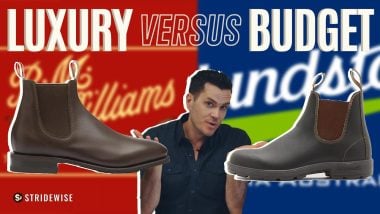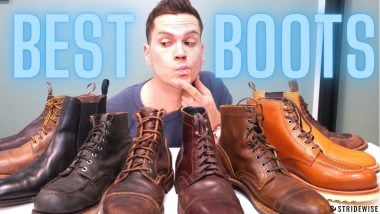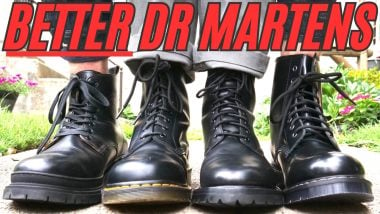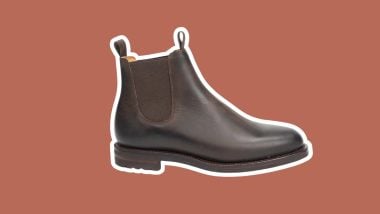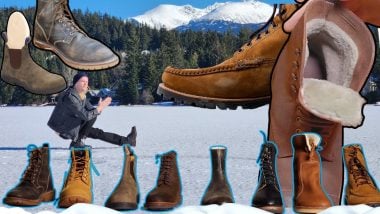Clinch Engineer Boots | My Two-Year Review
Hey folks, this is David from The Vintage Future YouTube channel, where I review heritage leather, canvas, and denim clothing and accessories. Today, I’m writing a comprehensive review of my Clinch engineer boots, combining information from two separate videos I’ve made (and embedded in this article below) to document my journey with what may be the most sought after engineer boots on Earth.
My first nine-month checkin video is below and even with less than a year, I was incredibly impressed with these boots. Let’s look through the details and look closer at the construction, leather, style, and how these held up after two years of wear.
Pros & Cons: Clinch Engineer Boots
In a hurry? Here’s a breakdown of my experience with these boots.
What I like
- Simply the best quality buckles, stitching, and finishing in the game
- Maryam Horsebutt leather wears and rolls well
- Narrow shaft opening is easy to fit under slimmer pants
- Teacore patina looks great and does not wear too fast
- Sole is from a lesser known brand but it’s great; the perfect balance between grip, comfort, and durability
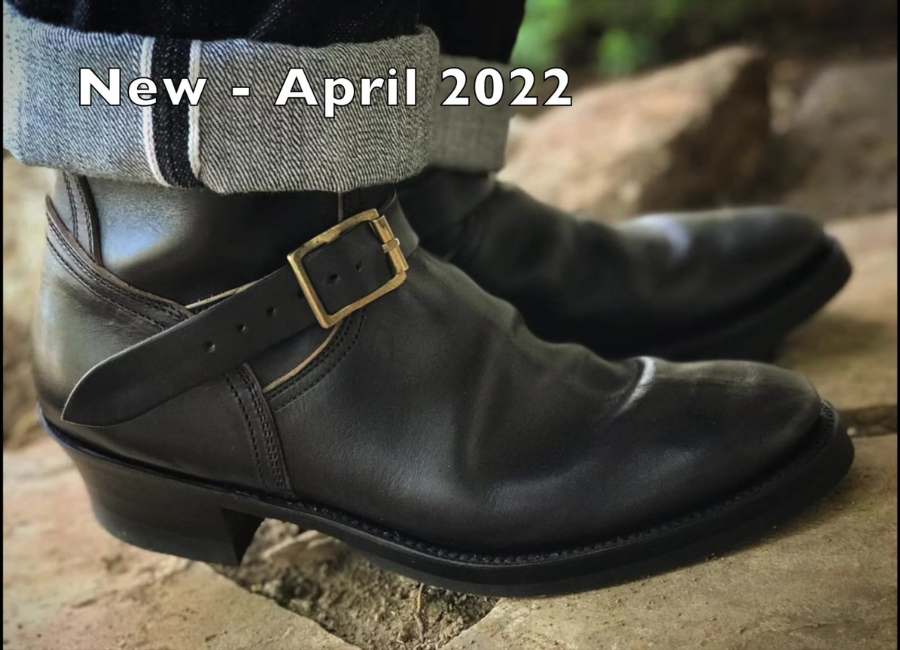
Downsides but not deal breakers
- Significant heel slip persists, though this may be because I have a low instep (consider tongue pads)
- Not great for low insteps or for wide feet
- Some guys in this space might prefer a chunkier, more dramatic boot
- You might prefer brown underneath the teacore; this reveals undyed leather instead
Further Reading
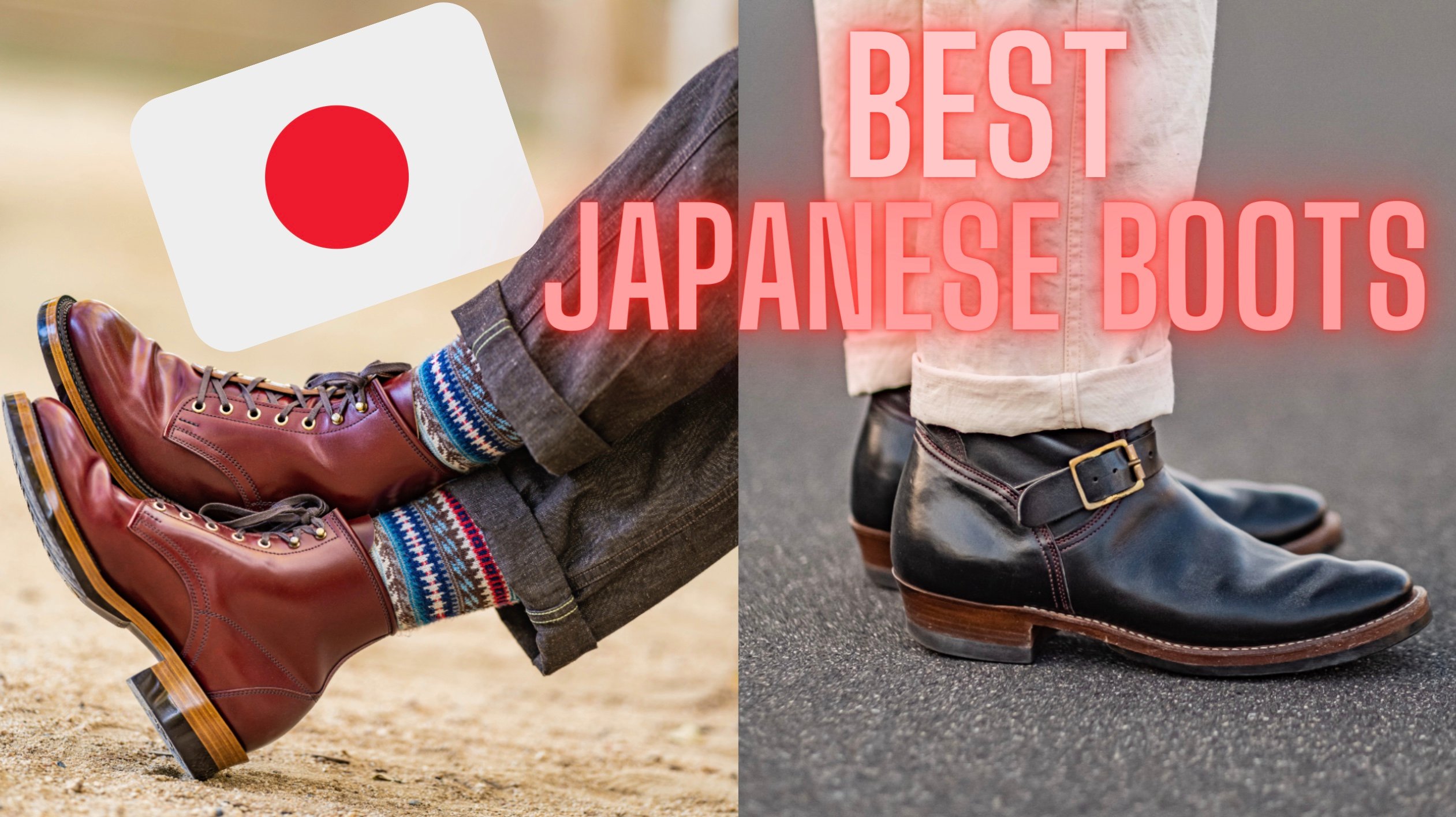
The 5 Best Japanese Boot Brands
Clinch is one of several engineer boots on our list of excellent Japanese boot brands. Learn more →
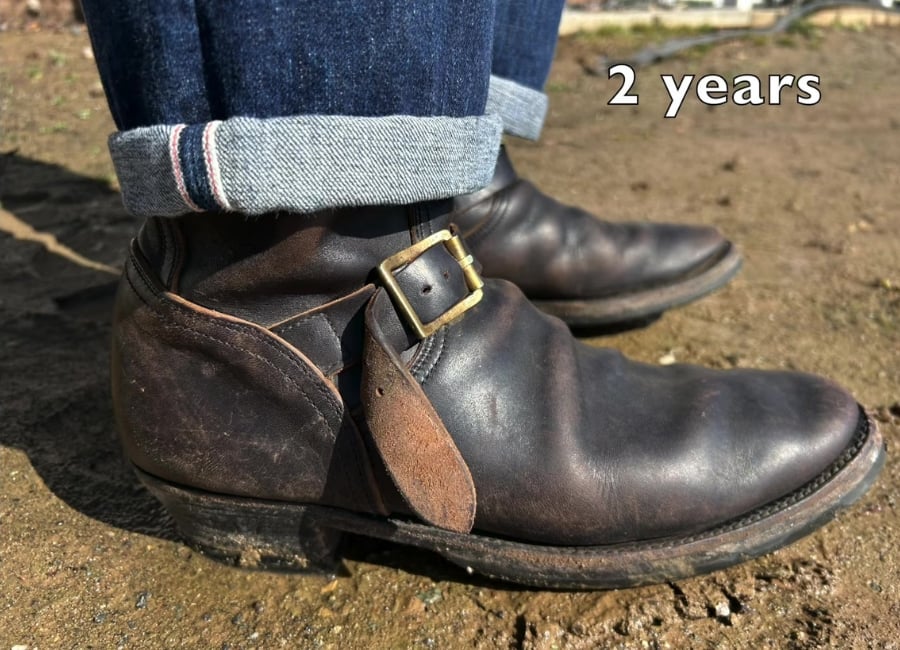
How I Tested My Clinch Engineer Boots
I have a relatively small rotation of about seven pairs of boots, so I put a lot of miles into each of them and see wear and tear pretty fast.
I’ve been purchasing and reviewing all manner of casual and durable menswear and footwear on my YouTube channel for years (here’s another boot review I’ve written for Stridewise) so I’m well practiced at assessing a product’s quality, and I do so with serious, long term wear.

So you know that it means something when I say I’m impressed with these Clinch boots, and it’s clear that they’ll last a long time.
With my tendency to drag and grind my heels, the soles wore through some of the treads, but I could walk at least another nine months or more with these before needing a resole.
Further Reading
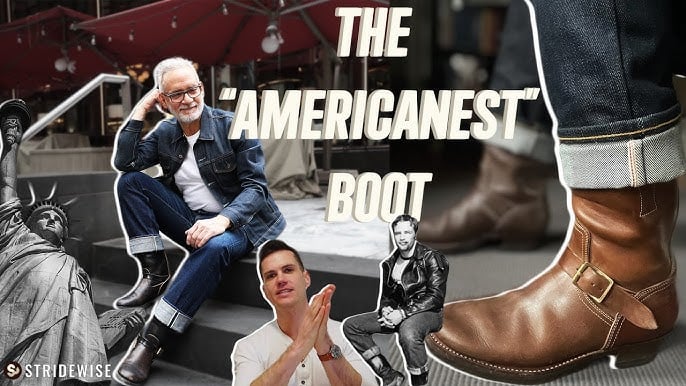
The Beginner’s Guide to Engineer Boots: How to Wear Them & Best Brands
We met up with engineer boot collector Albert to learn how to choose the best pair for you. Learn more →
I absolutely love beautiful, well-taken care of, clean engineer boots — like Jake’s from Almost Vintage Style.
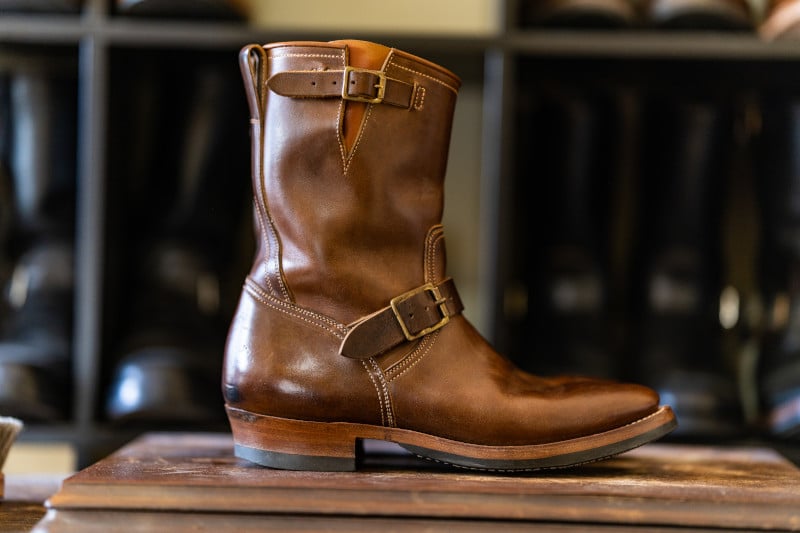
Jake takes great care of his boots, and on the other end of the spectrum is Minoru Matsuura, the brand’s owner. He kept posting photos of his engineers and jodhpurs that he wears in his workshop and they were totally beat up and vintage looking. That’s what really made me fall in love with that gnarly old boot look.
I try to wear each boot the way it’s asked to be worn. If it’s a rugged boot, I’ll wear it rugged. If it’s nice, I’ll keep it nice, trying to draw out what it’s asking to display to the world.
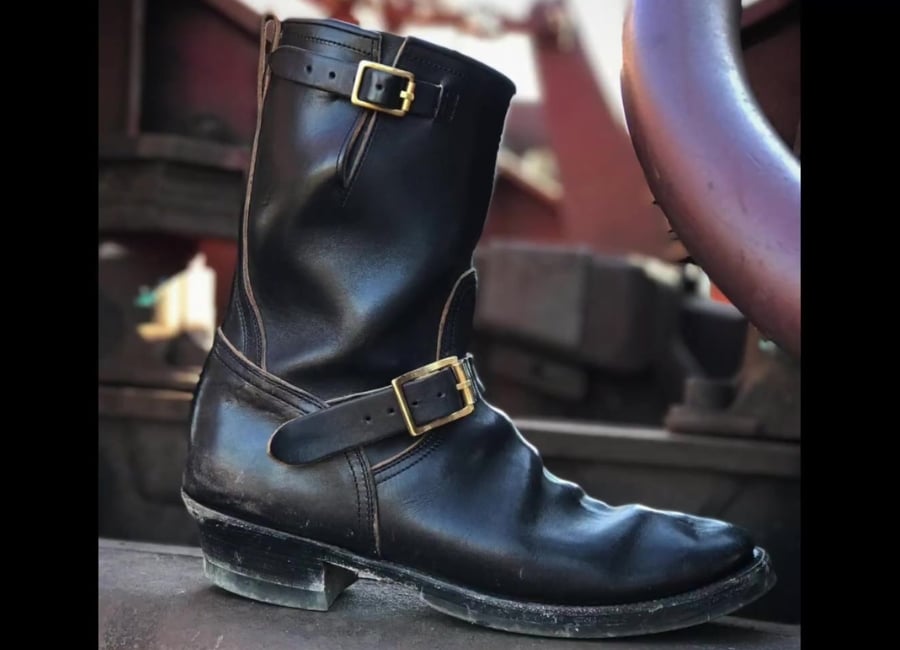
Specs: My Clinch 9” Engineer Boots
- Original CN Last
- Size 10 US/11 Clinch (for 10.5C Brannock US – note that’s on the narrow side)
- Hand-finished, black teacore Maryam Horsebutt
- Reproduction O’Sullivan half sole
- Black edge dressing and thread
- Brass roller buckles
- Flat welt that has both machine and hand-welting
- Rear pull tabs
- Unstructured toe
- Unlined
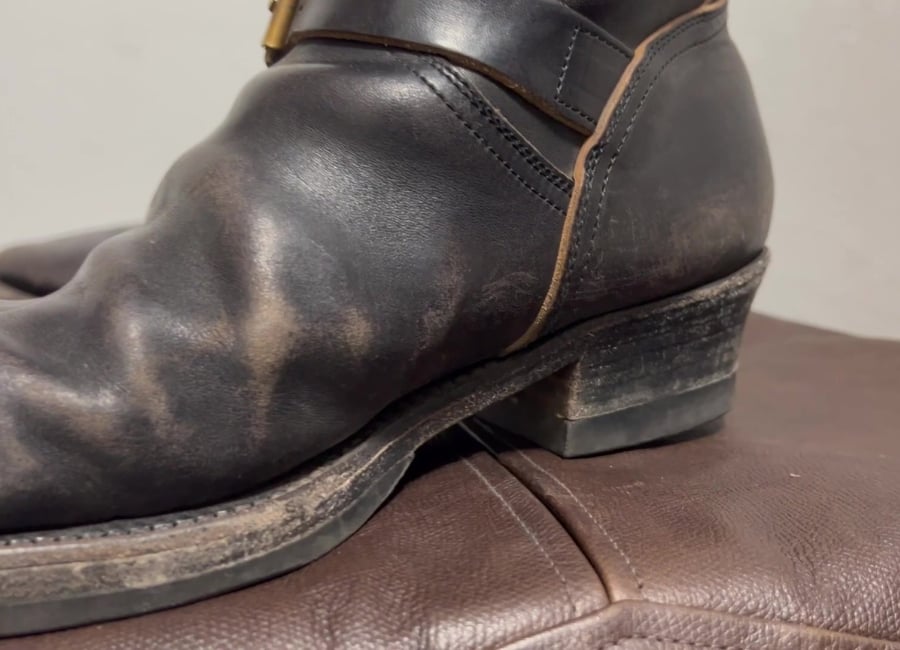
Leather: Clinch Engineer Boots
- Strong, dense horsebutt from the renowned Maryam Tannery in Italy
- Beautiful rolls
- Teacore leather; the black coat slowly wears away
If you’re not aware, Italy’s Maryam tannery is considered one of the best tanneries on Earth for making horsebutt. Some might argue that Japan’s Shinki Hikaku is the best, but plenty of others will go to bat for Maryam as the superior tannery.
The Maryam Horsebutt leather is dense and strong. I can see some wear marks on the sides and edge dressing, but I would not call it damage; it’s more of just splitting and chipping through the black overdye to the brown leather beneath. That’s what teacore leather is: the overdye is meant to wear away, giving a rewarding patina that’s yours.
It’s a natural tan color beneath the black, not a dark, warm, brown leather like you might see from another brand like Role Club. I’d have preferred that, but I still like this look a lot.
The most beautiful part of these boots is the rolls that have developed over my feet. Ideally, horsebutt will roll instead of creasing, like cordovan. Seeing gorgeous rolls in other guys’ boots drew me into this boot. I can tell that Clinch spends a lot of time selecting and hand-dying the most beautiful leather pieces for their boots.
One thing I definitely prefer with the Clinch boots is how slowly the teacore is wearing through. It’s definitely wearing more slowly than the teacore on my Role Club boots. This might just be my preference, but I like seeing the change happen slower and having to earn the patina a little more.
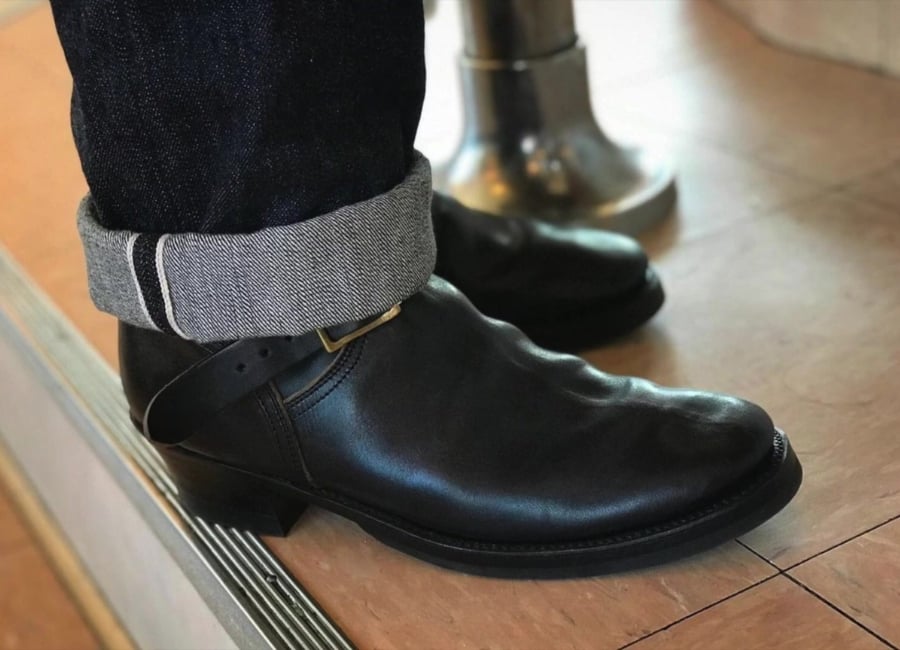
Construction: Clinch Engineer Boots
These boots are handling life really well. Nothing’s loose or falling apart. It’s been amazing in every way. They looked amazing in the new all-black finish, but they look even better now.
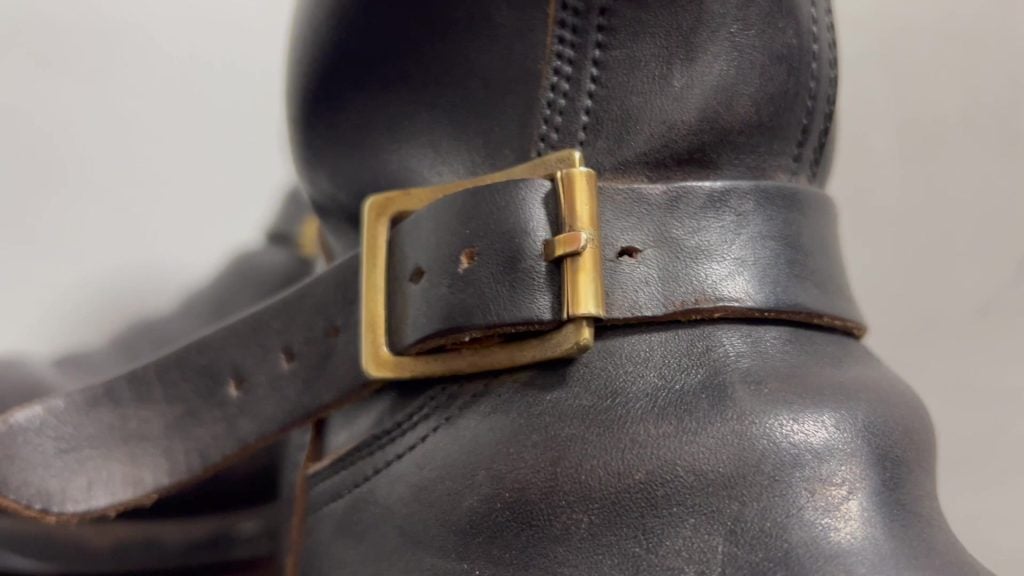
Hardware
The brass roller buckle is exceptional, and it’s probably the most hardy of the engineer boot roller buckles I’ve seen. I’ve owned Briselblack (a.k.a. Benzein), Role Club, and Clinch engineer boots, and Clinch seems to have the most robust buckles. At some point, with all three, the center prong loosened and started to fall off. I figured out how to get pliers inside to pinch the loose piece down inside to prevent this issue from getting worse.
One thing to note is that I tighten the straps down about as far as they go because I have a low instep, and it’s the only way these will stay on. You can see my attempts at punching even more holes in the strap with a nail and a leather punch to get them even tighter. Even with the straps fully tightened, I can still get my foot in and out, so I will say the “CN last” used here is not the best for those who have a low instep.

Heel & Sole
This is the 9-inch shaft height version instead of the full-size 11-inch. I lucked out with this pair because they have my favorite (smaller) version of the woodsman heels out of the several types that I have seen Clinch use. They are the perfect pairing to the O’Sullivan’s reproduction half sole.
The soles are soft enough to be comfortable and hard enough to wear slowly. I’ve noticed that they are actually oil-resistant and grippy, unlike many others that I have tested.
The additional tacks, leather midsole, and hand/machine stitching also look and function great. I love how they trimmed the sole so close to the heels — it shows the skill and focus on the craftsmanship here.
Toe
The shape of the toe squares off and becomes flat in front. It’s similar to a Briselblack/Benzein, and this boot may have inspired theirs. The toe is springing up slightly on both boots, and I like the way the unstructured toe is collapsing.
From a technical perspective, these Clinch boots are the nicest of the three pairs of engineer boots I’ve owned. As Jake mentioned in one of his videos, I recently saw a few guys having some issues with Clinch, but this particular pair came out nicely, and I haven’t seen any manufacturing defects to speak of.

Sizing & Fit: Clinch Engineer Boots
- Most D widths and narrow/low volume should go ½ size down, as Clinch recommends
- High volume D or wider might be able to make Brannock size or half size up work
- Not great if your feet are wider than an E
My boots are on the original CN last in size 10 US (Clinch size 11). One thing I’ll say is not great for people with low insteps, and these are known for being narrow. They are good for people with a D width or less. If you’re an E width, you could possibly wear them if you go a half size up. I don’t think you will like the fit if you have feet wider than an E.
I find that Clinch boots typically have huge heel cups despite the narrow last. In these and a pair of Hi-Liners and Jodhpurs I had, I experienced a ton of heel slip. Even laced into broken-in, 14-inch shaft height Hi-Liners, my heel still flops around inside. This is probably fine for a lot of people but it’s an issue that I had to learn to live with because I have a low instep.
I’ve tried adding the extra strap holes, as mentioned, but I didn’t try to add insoles or tongue pads like Pedag’s, which are a favorite fit adjuster of Stridewise’s editor Nick. These are two possible solutions for heel slip that might work out if you’re concerned.
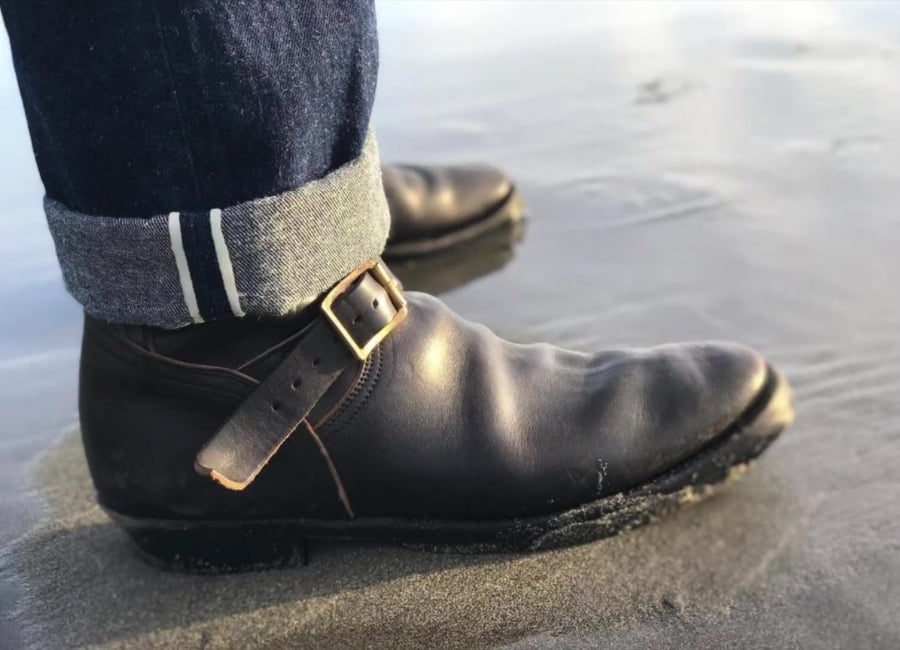
Style
- The lower shaft height can look out of proportion to some
- The pull straps work well
- Tightening the upper strap can fit shaft under even slim leg openings
Some people might think the look of the 9-inch height shaft looks out of proportion to the length of the foot, especially if you wear a small size. It seems common for engineers to have the shaft height be higher than the length of the bottom. I’ll admit that it does look a little off not to have the taller height-to-length ratio. But I don’t really care, they look absolutely stunning and incredible.
Pull Tabs
The 9 inch version doesn’t have the little interior pull straps hanging down on the sides of the shaft that the full size 11-inch boots have. Those are helpful for pulling your foot down into the boots. Mine have back pull tabs instead, which I do use and it’s a nice feature to have.

Shafts
The shafts, similar to my Role Clubs, are nice and narrow and fit under fairly slim denim leg openings. I think you could get these under even a 7.5 inch opening, especially if you tighten them up top. I usually wear 8.5-10 inch leg openings, so it doesn’t matter much to me, but it’s going to be a big draw for guys who like slimmer legs.
The nine-inch shaft is cool because it reminds me of roper boots compared to cowboy boots, which are smaller and more portable. They’re just great; you throw them on quickly and run around. I don’t feel the need for a huge shaft under my pant legs.
Vintage Look
The boots’ iconic vintage look attracts all kinds of comments from people. They say I have Santa/ pirate/ motorcycle/ cowboy boots, but I don’t care. I love the look and wearing them, and that’s what counts, right? If you’re in love with this particular aesthetic, then they’re worth it. Plus, pirates and cowboys and bikers and Santa are all cool as heck.
Clinch Engineer Boots Alternatives
Clinch offers a rare level of quality, but there are some others in the space that a lot of boot nerds consider comparable, or at least a good substitute.
Unfortunately, all the brands making good competitors to Clinch have long wait times. But they’re still considerably easier to buy than Clinch!

For niche brands with cult followings but a long wait time, there’s Briselblack (above) and other Indonesian brands, Flame Panda in China, and in Japan there’s Zerrows, Moto(r), John Lofgren, and Attractions.
In the US there are good engineer boots from White’s and Nicks — you’ll have to wait for them to be made, but they’re easier to buy and the wait will probably be shorter.
I think you should get something that fits you and that you absolutely love the look of. That should determine the choice. If you can find that combination, it’s going to be worth the higher price you pay, and it’ll be a better boot for you than if you got a better known boot (like Clinch, even) that doesn’t fit as well.

Some boots I have tried just did not fit right, like the Wesco Mister Lou boots. They dig and push my big toe in, and it drives me nuts, so I can’t wear those. Viberg also makes some amazing engineer boots, but their last is too big for my skinny foot, and the boots constantly want to fall right off my feet.
How Clinch Look & Feel After 2-Years
- A few nicks, but nothing needs repair
- The heel caps and soles are still going strong
- Every inch of the boot shows unique wear patterns
After two years of continued wear, you can tell I still wear them pretty hard. In fact, I wear them more than any of my other boots. They’re my kick-around boots. The teacore aging is really prominent with these, and I think they are amazing.
Comfort
They’re not quite as comfortable as my Briselblack engineer boots, which fit me a little better. Clinch’s CN last is fine, but it’s still not the best for my foot. That’s not a knock against the brand or the build, it’s just a fact of my particular foot anatomy.
Today, I hardly wear my Role Clubs anymore. They’re amazing boots, but the Chromexcel leather stretched out and changed the fit to the point where I couldn’t wear them anymore. So my Clinch and my Briselblacks have completely replaced them.

Teacore
They still read as black when you’re wearing them or when you see them from far away. Up close, you can see that brown coming through the worn black over-dye in a big way, especially on the heels. The boot shafts are also fading to a deep brown shade.
Edges
The edge dressing all around the boots was originally pitch black, and now you can see it has been wearing away after a couple of years while still holding up nicely. I have noticed that I’m getting some holes around the sides and welts, but nothing will require repair.

Rolls
The rolls don’t perfectly match each other, but I like how each boot is unique. My feet probably have differences between them as well. I’m sure the rolls will even out over time, though.
I suspect they came out extra-pronounced due to all the extra material around my skinny foot. The unstructured toes have developed a little toe spring that looks perfect to me.

Soles
You can expect this if you put a lot of wear on teacore Clinch horsebutt boots, and you can see they have miles and miles left to go. I love these soles even more now that they have continued to perform well in all conditions and still have life left in them. Even the heel cap — which shows a lot of wear and tear from my heel dragging — has a long way to go before it needs to be replaced.
Wrapping Up
I’m so happy with this pair of boots: the leather, the construction, and the style are all great despite the imperfect fit. Overall, I’m glad I’ve got these and enjoy wearing them. Thanks for taking a look at my review. Until next time, let your boots take you to places more important than the boots themselves.
Follow the author at his YouTube channel: The Vintage Future.

